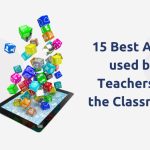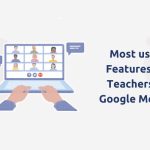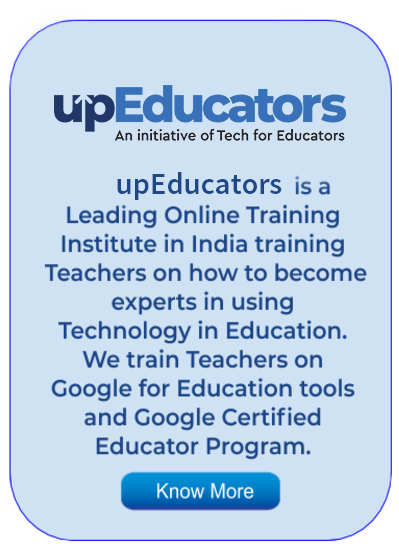“Teaching is more than imparting knowledge; it is inspiring change. Learning is more than absorbing facts; it is acquiring understanding”
– William Arthur Ward
Learning is a continuous process that goes on till our last breath. A good teacher is somebody who can oscillate between the past and the present to give the students a bright future. A modern-day teacher must be aware of the roots of learning yet should be able to integrate modern ways of learning in imparting education.
The modern man interacts with technology every day. The introduction of the internet and social media has had a colossal impact on the modern generation. Even the younger generation is exposed to smart screens every day.
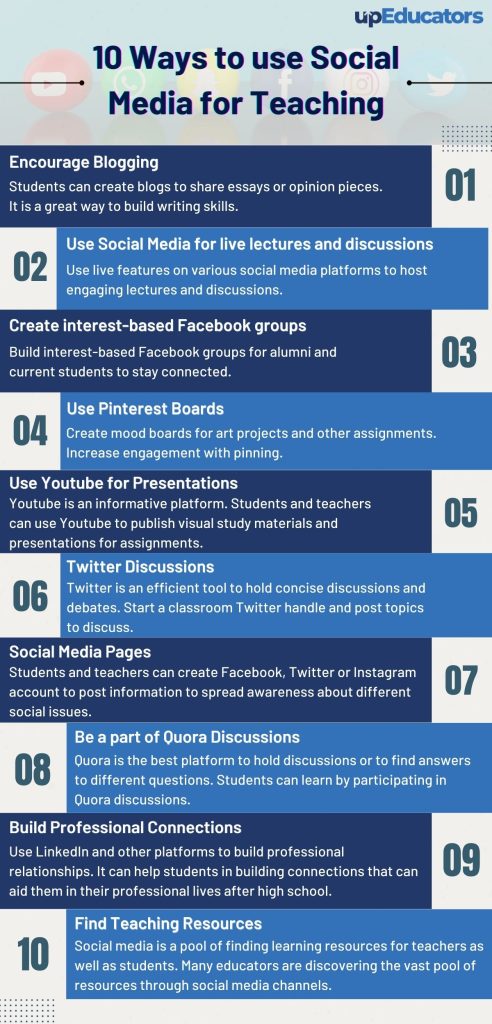
A 21st-century teacher can turn this phenomenon into an opportunity and make students learn better by using the internet and various social media platforms in the classroom. A lot of contemporary teachers have witnessed the advantages of integrating social media channels as modes of learning in their classrooms. The names of digital educators like Khan Sir and Alakh Pandey, popularly known as Physics Wallah, are becoming common household names in India.
Benefits of Using Social Media for Education
Teachers in the 21st century must be able to combine the traditional modes of learning with the modern methods of imparting education. The use of technology and social media can bring positive change to the education sector. It can improve the quality of learning and help even those who can’t afford to attend school. There are a lot of benefits of integrating social media platforms into everyday learning.
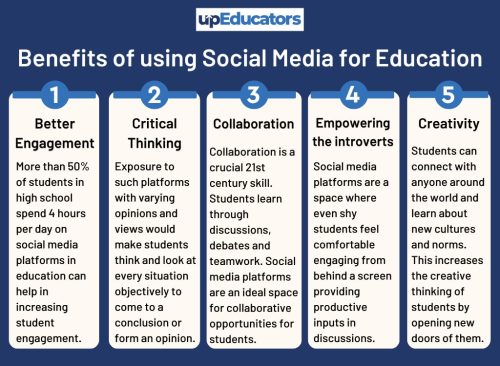
How to Use Social Media for Teaching?
A recent study shows that the use of social media platforms helps in shaping research skills and aids in better self-learning for students. There are a lot of social media platforms available that can be integrated by teachers in the classrooms to enable better learning. upEducators – A Google for Education Partner Company – has trained thousands of educators in using Social Media, Digital Marketing and Education Technology. Based on research, feedback from thousands of Teachers and ratings, upEducators found out the best ways in which teachers can use social media platforms in teaching. Here are some approaches that can be applied by teachers in using different social media platforms for better learning in classrooms.
1) Encourage Blogging
Blogs were originally started in the early 90s as a way to share opinions and views on various subjects. Blogging has evolved as a marketing tool but teachers and learners can benefit a lot from various blogging platforms. Here’s how educators and students can benefit from blogging.
- Teachers must encourage students to make personal blogs and write and share their essays via blogging. For instance, students in a classroom can interact and share opinions on a subject through blogs. Commenting and holding discussions in a blog is one of the best methods to hold positive and compelling discussions among students.
- In addition to this, teachers can help and encourage students to improve their writing skills through blogging on various topics discussed inside classrooms or even to write their views on a specific topic.
An English teacher witnessed higher student engagement as she asked her students to submit essay-type questions on the novels in the curriculum by making a blog. Students were motivated to submit their work and came up with creative log ideas to showcase their essays.
2) Live Lectures and Discussions
Remote learning and hybrid learning are becoming common phenomena in the post-covid world. The live feature from various social media platforms like Instagram and Facebook can be used to hold live discussions and lectures when students are not able to be physically present in the classrooms. Absent students can benefit a lot from live lectures and discussions.
In a recent survey conducted on Australian students, more than 60% of pupils responded positively to online learning via Zoom in the post-Covid years. Such researches show how remote learning is a possibility with platforms like Zoom and Google Meet.
3) Create Interest-Based Facebook Groups
Both the current students and the alumni can benefit from social media groups. A lot of schools are using this feature to keep ex-students connected and involved with the happenings in the institute. Similarly, schools and teachers can make use of social media groups like Facebook Groups to build interest-based groups for students who are interested in similar topics.
These groups can be used to connect with like-minded students, hold discussions on topics of interest or just stay connected and updated with what is happening in the school.
4) Pinterest Boards
Pinterest is a great tool to make mood boards and boards related to a specific topic. Art students and learners can benefit a lot from Pinterest to collect and organise inspirations for their creations. In addition to this, Pinterest boards can also be created by different classes. Subjects or topics and students can pin their ideas on a board which can be discussed or used later while doing assignments.
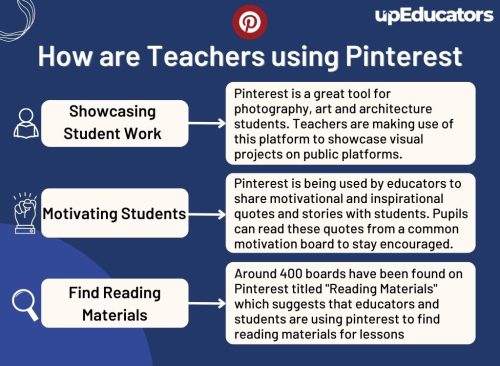
For instance, a Geography teacher can create a Pinterest Board for a specific city and ask students to pin their unique pictures from that city on the same board with their names. Such exercise would help in introducing Geography lessons more efficiently.
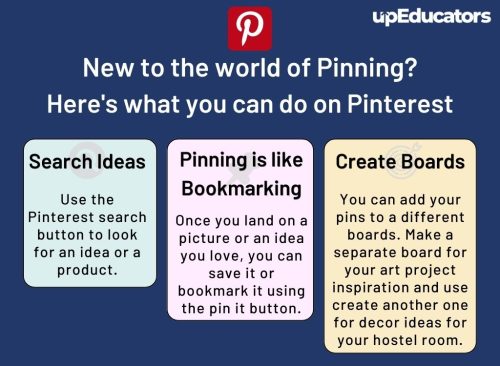
5) Youtube for Presentations
Youtube is the best video streaming platform but its uses and functionalities are not limited to entertainment. Youtube is an informative platform where a lot of study material from experts is present in the form of videos and short clips. A recent survey depicted that more than 50% of Youtube users are using this platform for educational purposes
- Teachers can use Youtube for uploading and sharing informative videos on different lessons or students can use this platform for presenting a video or presentation in the classroom. The videos can be accessed by anyone around the world and thus it provides a platform to share your opinions in the form of videos with the world.
- Youtube is a hub for educational channels. Videos from popular Youtube Channels like TedEd can be used by teachers to introduce or explain a topic interestingly.
6) Twitter Discussions
Twitter is an efficient tool to hold concise discussions and debates.
- Teachers can form a Twitter account for a specific class and post a topic of discussion every day.
- Students can post their opinions on the topic as Twitter threads or it can help students to express their opinions concisely and briefly due to the character limits per tweet.
- Teachers and students can decide on a few hashtags to be followed on Twitter to stay updated on a particular topic related to a lesson in class or just to stay aware of a social topic.
7) Social Media Pages
Social Media platforms can be used in making students more aware of social issues. They can also be used by students to spread awareness about different social issues. Students and teachers can create Facebook pages, Twitter pages or Instagram account to post information related to a social issue in their locality. A lot of people are using social media to spread social awareness and students can learn and educate from this feature about social evils and issues.
For instance, The University of New Hampshire uses its Facebook page to share on-campus updates and social awareness. They post updates about upcoming social days like Juneteenth and the historical significance of the national holiday.
Similarly, Grove Road Primary School in Harrogate, UK uses social media platforms like Twitter in different ways. One of the many ways is to post updates regarding classroom activities. From science week activities to a virtual marathon for a social cause, the official Twitter handle of Grove Road School is filled with daily classroom updates.
You can check out the Twitter handle here and take some inspiration for your institute.
8) Quora Discussions
Quora is the best platform to hold discussions or to find answers to different questions. Teachers can post a question related to the lessons or on a general topic. Students can be asked to provide answers or to post their opinions in the comments. This could lead to a productive discussion and a learning session for the students.
9) Build Professional Connections
Social media platforms like LinkedIn are an ideal tool to help students in building professional connections. Students can create LinkedIn profiles and connect with like-minded professionals from a specific industry. Platforms like LinkedIn can help students in building connections that can aid them in their professional lives after high school.
Such platforms are also ideal for home-schooled students. They can connect with teachers, mentors and other students and learn a lot from such professional connections while continuing home-schooling. These platforms are beneficial for both the home-schooled and regular students.
For instance, a group of science students developed a robot but they needed professional assistance to make it move. They used LinkedIn to reach out to the mentors and experts who helped them in not only making the robot work but also promoting their work on such professional platforms.
10) Teaching Resources
Many educators are discovering the vast pool of resources through social media channels. For instance, a lot of teachers follow education-specific hashtags on Twitter, Instagram and Facebook to get access to learning and teaching resources. In addition to this, teachers can easily connect with experts and popular personalities via social media. Guest lectures and webinars by such experts help in enhancing the teaching-learning process.
Social media platforms, if used wisely, can be a huge advantage to students and teachers inside and outside classrooms. But teachers and parents need to ensure that the students do not misuse these tools. Social media platforms in educational institutes must be used by maintaining a healthy environment without disturbing the decorum of the institute. Students must be trained to use these platforms professionally. Social media platforms along with technology can help students in approaching learning with zeal and vigour.
Author: This article is written by Samiya Rashid for upEducators blog.


